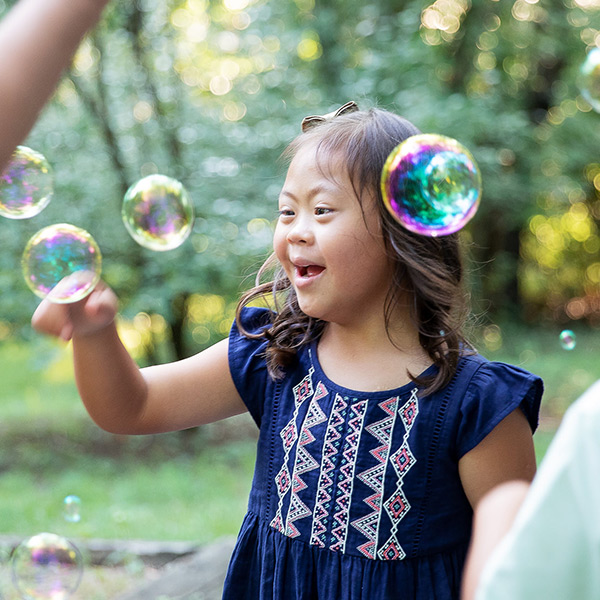How to Help Calm Your Dysregulated Child or Teen

In our roles as parents and/or caregivers, we have all experienced moments when our children and/or teens find themselves in states of dysregulation or distress. In some instances, those states of dysregulation or distress involve no threat of danger or harm, but we must be clear-eyed to the fact that some moments could prove otherwise. For children who have been impacted by trauma, instances of dysregulation or distress can sometimes be more complex or challenging to navigate. Later, we will address and offer potential solutions to those times of dysregulation or distress in your child or teen, but before we go any further, it is important to have a better understanding of the brain’s complexities, wiring, and development.
The human brain is like a two-story house. The “upstairs brain” allows us to think, reason, learn, remember, and regulate our emotions and is mostly unwired at birth. It takes time and experience for the upstairs brain to become hardwired. The “downstairs brain” is mostly wired at birth and allows a newborn to eat, sleep, drink, stay warm or cool, and eliminate. A newborn’s reflexes and basic bodily functions are rooted here. When a child experiences trauma, it can impact the wiring and chemistry of the brain—the lower, more primitive parts of the brain can overdevelop from reactions to fear and efforts to survive while the more sophisticated upstairs brain remains underdeveloped. Repeating nurturing experiences can strengthen connections to the upstairs brain, so it can help regulate the downstairs brain, strengthening the balance between the two parts of the brain. If a child spends too much time in fear, the brain organizes itself around the survival response—fight, flight, or freeze—and the downstairs brain runs the show. Without felt safety and the ability to trust, the more sophisticated functions of the upstairs brain are largely inaccessible to a child.
Children who have experienced trauma need parents, caregivers, and communities who are insightful, prepared, equipped, and committed. As the late Dr. Karyn Purvis once said, “All children need to know that they’re precious and unique and special. But a child [who has experienced trauma] needs to know it more desperately.” Developed by Drs. Purvis and David Cross at the Karyn Purvis Institute of Child Development at TCU (KPICD), Trust-Based Relational Intervention® (TBRI®) is designed to meet the relational and developmental needs of children and teens impacted by trauma as well as the needs of the parents and caregivers who are seeking to help them thrive and flourish. TBRI considers the whole child—his or her brain, biology, behavior, body, and beliefs—and provides parents and caregivers with practical tools and insights to help their child(ren) reach his or her highest potential. And, perhaps most integral, TBRI has connection at its core—the truth that connection builds trust, and trust builds healthy relationships.
The goal of TBRI Connecting Principles is to build trusting relationships that help children and youth feel valued, cared for, safe, and connected. Disarming fear and building trust greatly increase the capacity for connection, growth, and learning. Included within TBRI Connecting Principles are both Mindfulness and Engagement Strategies. Each set of strategies are integral before, during, and after times of dysregulation and distress.
Mindfulness Strategies
- Identify the thoughts, beliefs, and behaviors you bring to relationships based on the care you received.
- Realize how these thoughts, beliefs, and behaviors influence your relationships.
- Identify personal triggers. Ask yourself, Why does this behavior or situation trigger me so much?
- Practice regulating yourself during times of stress:
- Pray.
- Take 10 deep breaths.
- Go for a walk.
- Remind yourself, It is my job to help my child regulate.
- Stay calm and emotionally present during a child’s distress. This allows you to:
- Think flexibly.
- Solve problems creatively.
- Model compassion.
- Co-regulate with your child.
Engagement Strategies
- Use an appropriately authoritative voice, a blend of structure and nurture—never weak, shaming, or harsh.
- Value eye contact (but never force):
- Can I see your eyes, please?
- I love seeing those beautiful eyes!
- Match your child or teen’s body position, posture, and voice.
- Incorporate healthy touch (with permission):
- Chin prompt
- Hand on shoulder
- Hugs
- High fives or fist bumps
- Interact playfully:
- Play games.
- Be silly together.
- Use imaginative play.
One of the most important outcomes of TBRI Empowering Principles is to teach the capacity for regulation. These skills can be taught through modeling; practicing co-regulation; and by using physical exercises, daily routines, and/or nurturing activities. The goal is to give children the tools needed to use their brains and bodies to keep their internal state regulated and balanced. This is learned through healthy relationships. Our own personal past experiences and history will influence how we perceive a new experience. The brain develops in sequence and will heal in sequence. Therefore, a child’s ability to access any part of her or his brain that is not fully developed due to age or traumatic influence will be impaired. The following two strategies are also integral before, during, and after times of dysregulation and distress for your child or teen.
Physiological (Physical/Internal) Strategies
- Have your child’s physical needs been met?
- Manage sleep, hydration, and blood sugar.
- Meet nutritional needs.
- Engage sensory needs by providing physical activity, at least, every two hours.
- Teach regulation by modeling and practicing regulation skills in physical and/or nurturing activities throughout the day.
Ecological Strategies
- How is the environment affecting your child or teen? In what ways can you modify the environment to help your child, and/or how can you prepare your child for the environment?
- Use daily rituals that are predictable.
- Create morning and evening routines and stick to those.
- If possible, communicate any changes to the schedule with your child in advance.
- Foster and model predictability in transitions (i.e. “in five minutes, we will …”).
- Develop awareness about the levels of sensory input—both for those who are sensory seeking and those who are sensory avoidant.
- Consider noise levels, unfamiliar or strong odors, lighting, tactile experiences, and so forth.
- Use daily rituals that are predictable.
The goal of TBRI Correcting Principles is to help children learn appropriate strategies for getting their needs met and to learn to navigate successful interactions throughout their day. As you approach correcting, it is important to remember the following hallmarks of “Connected Parenting.”
- Time-ins vs. Time-outs
- Bringing your child closer vs. Sending him or her away
- Choices and Compromises vs. Consequences
- Problem-solving vs. Lectures
- Advocacy stance vs. Adversary stance (Coach vs. Warden)
- Focus on your child’s preciousness vs. Focus on his or her failures
Solving behavioral challenges quickly and effectively while building connection between the caregiver and child is a primary feature of TBRI. The IDEAL Response© is a key component of the TBRI Correcting Principles.
- Immediate: Respond immediately.
- Direct: Engage directly (with eyes, proximity, and touch when possible).
- Efficient: Maximize playfulness when possible, and use only the Level of Response that is essential for addressing the challenge.
- Action-Based: Give your child a chance for a “redo.” Maximize learning by creating body memory for the right choices.
- Leveled: Direct at the behavior, not the child. Make it clear to your child that you are her or his advocate, not adversary.
Foundational to TBRI is the premise that most behavior is driven by unmet needs. Ask yourself the following questions when your child or teen is using behavior to communicate something she or he doesn’t have the words to express:
- What is this behavior really saying?
- What does my child really need?
- How can I teach my child to get his or her needs met in healthy ways?
- How can I teach this skill at a calmer time?
And to help disarm fear and negative behaviors in children or teenagers who are being disruptive, consider asking questions like:
- Can you tell me what you need?
- How can I help you?
As you navigate Correcting Principles, the ultimate goal is to complete all interactions in such a way that behavior is changed, the connection is strengthened, and both you and your child or teen are content. The following are some very practical strategies, from the KPICD, to try and implement during instances of dysregulated, distressed, and/or disruptive behaviors:
- Simply give your child or teen an opportunity to “re-do” the behavior, particularly in low-level challenges (i.e. child or teen is disrespectful or sassy). Since motor memory is formed through active participation, deep learning occurs. A re-do can be either physical or verbal. With younger children, physical re-dos are powerful, but with adolescents, it may be best to just ask for verbal re-dos since they may feel shamed otherwise. The following are examples:
- Are you asking or telling?
- Can you try that again with respect?
- I want to meet your needs, but I need words that I can understand. Can you try it again with respect?
- Provide choices to give your child or teen a sense of safety and “buy-in” toward the resolution. Again, give the child or teen an opportunity to re-do the behavior. Since motor memory is formed through active participation, deep learning occurs. This strategy is particularly helpful in a higher-level challenge when no one is in danger, and there is no threat of physical harm.
- Consider offering compromises, similar in nature to choices. Compromises are powerful for giving voice, sharing power, and inviting your child or teen to collaborate in solving their needs and/or problems.
- Give your child and/or teen an opportunity to self-regulate, especially when a challenge is accelerated and the risk for danger or harm is elevated. You must remain calm and focused. Your voice should be firm but not threatening. Use fewer words and talk more slowly because cognitive areas of the brain are less active during these times. The following are some additional strategies for calming:
- Create a “calming space” in your home. Invite your child or teen to go to that space and think about what he or she needs. (After a few minutes, check on your child or teen to see if he or she can co-regulate and solve the problem.)
- Take a brief walk with your child or teen to help him or her calm (the bilateral movement will help the brain organize).
- Create a sensory area where your child or teen can, for example, sit in a bean bag chair and cover up with a weighted blanket until he or she calms. This area could also include fidgets or sensory buckets of rice, beans, etc. where he or she can calm.
- Provide safety for all who are involved, including your child or teen who is dysregulated. This is especially important when there is an active threat of danger and/or harm. This can look like the following:
- Remove either the child who is distressed or those around who are witnessing the situation. Seek help from another adult who can stay with other children while you stay with the child or teen who is erratic.
- Find a private, quiet space where the child or teen can be kept safe, removing objects that might become harmful.
- Remain calm, using few words, and encourage your child or teen to breathe. (Consider “calm plus five,” where your child begins to calm, and you ask him or her to breathe and relax further for five more minutes.)
- As your child or teen calms, ask him or her to sit and talk. Calmly ask him or her what he or she needs.
- Once the situation is resolved, meet any physical needs as he or she may be exhausted.
We all have moments in our daily lives when we are dysregulated and distressed. This is especially true for children and teens who are still learning how to regulate and calm their minds and bodies. And for children and teens who have experienced trauma, instances of dysregulation or distress can sometimes be more complex or challenging to navigate. Children and teens who have experienced trauma need parents, caregivers, and communities who are insightful, prepared, equipped, and committed. If you are interested in learning more, we invite to join us for our annual Hope for the Journey Conference. This conference is your gateway to a wealth of knowledge, understanding, and practical tools to better help support the children and teens entrusted to your care, whether that is in your family or home, at your church, within your school or classroom, or in your practice or organization.
For one last quick tip, check out this video on our TikTok account.



